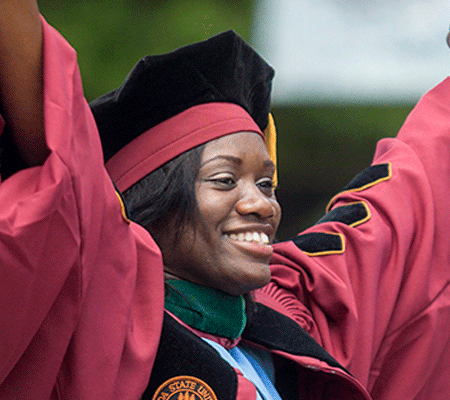
Fifteen years after enrolling its first class, the Florida State University College of Medicine has emerged as one of the most diverse medical schools in the country, according to current Association of American Medical Colleges (AAMC) enrollment data.
The FSU College of Medicine is the only AAMC-member institution ranked in the top six for enrollment of both black and Hispanic students among 136 U.S. medical schools. Its enrollment percentage for black or African-American students is double the national average.
Through its first 12 graduating classes, FSU’s medical school has produced 106 black and 135 Hispanic physicians.
“Our numbers are a reflection not of chance, but of design,” said John P. Fogarty, dean of the FSU College of Medicine. “We have a very specific mission to produce more physicians for Florida’s underserved communities, urban and rural, and we know that the only way to do that is to bring in students who are more likely to practice in those areas one day.”
From 1980 to 2012, only 17 AAMC medical schools (none of them in Florida) graduated 350 or more black or African-American physicians, and only 17 (including four in Puerto Rico) graduated more than 400 Latino or Hispanic physicians.
“We are on pace to exceed those numbers in a shorter time frame,” Fogarty said, noting that the college only reached its full enrollment five years ago.
The AAMC’s Missions Management Tool (MMT), which provides data allowing medical schools to assess their performance in a variety of areas related to mission, also rates Florida State one of the top programs in the nation in the category of preparing a diverse physician workforce.
The MMT places Florida State among the top 10 percent of medical schools in the country for percentage of graduates who are African-American. At the same time, Florida State rates as one of the top 15 percent of schools for percentage of graduates who are Hispanic.
The diversity programs meant to bolster enrollment of minority and rural students in medical school at Florida State also appear to be influencing undergraduate enrollment at the university. In 2016, FSU ranked No. 8 nationally for the number of its black or African-American graduates accepted into medical schools.
Many of those undergraduates were involved in a variety of College of Medicine outreach efforts, including the Undergraduate-SSTRIDE (Science Students Together Reaching Instructional Diversity and Excellence) program and the Minority Association of Pre-Medical Students.
“FSU’s commitment to the success of our students — all of our students — is demonstrably reflected in these important programs,” said Sally McRorie, provost and executive vice president for Academic Affairs.
Diversification of the U.S. physician workforce has lagged significantly behind diversification of the population as a whole and threatens to present challenges in meeting public health needs.
In a review of 55 published studies on the topic, the U.S. Health Resources and Services Administration reported on the rationale for diversity in health professions by concluding:
- Underrepresented minority health professionals, particularly physicians, disproportionately serve minority and other medically underserved populations.
- Minority patients tend to receive better interpersonal care from practitioners of their own race or ethnicity, particularly in primary-care and mental-health settings.
- Non-English-speaking patients, particularly in mental-health care, experience better interpersonal care, greater medical comprehension, and a greater likelihood of keeping follow-up appointments when they see a practitioner who understands their language.
In Florida, 40 percent of the population — but only 21 percent of the physician workforce — is black or Hispanic, according to the U.S. Census Bureau and the Florida Department of Health.
“I think that diversity has moved from what I’d say was an important issue to an urgent issue,” said Marc Nivet, the AAMC’s chief diversity officer. “Clearly there’s something good that’s happening at Florida State. It’s a fantastic message that should be shared with all medical schools because we all could learn from that.”
Before enrolling its first class 15 years ago, the College of Medicine already had an established pipeline program meant to expand the pool of qualified applicants from underserved backgrounds. SSTRIDE was developed in 1993 to help FSU’s Program in Medical Sciences (PIMS) achieve greater diversity.
PIMS ended in 2001 when the FSU College of Medicine’s first class arrived. SSTRIDE remained, giving precollege students from rural and urban underserved areas exposure to opportunities that would help prepare them for a career in health care.
“SSTRIDE identifies talented students when there is still time to put them on the right path for being successful in the medical school application process,” said Helen Livingston, associate dean for undergraduate and graduate programs at the College of Medicine.
The College of Medicine has since added additional pipeline programs, including the Summer Institute, the Bridge to Clinical Medicine and the Honors Medical Scholars Society (HMSS).
A snapshot of outreach program success at the College of Medicine:
- SSTRIDE — 98 percent of high-school seniors in the program are admitted to college.
- U-SSTRIDE — More than half of the undergraduates in the program go on to medical school, with the vast majority of those choosing to attend the FSU College of Medicine.
- HMSS — 90 percent of participants to date have entered medical school (87 percent at FSU). Seventy-two percent of those who have already graduated from medical school at FSU have entered primary-care residencies.
- Summer Institute — 99 percent of participants (2008-2015) have gone to college, and 85 percent of those have majored in or are majoring in math, science or health-related fields. To date, 11 percent of participants have gone on to medical school.




